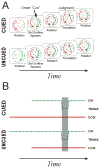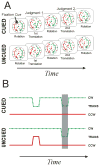Exploring the mechanisms underlying surface-based stimulus selection
- PMID: 19941882
- PMCID: PMC2813929
- DOI: 10.1016/j.visres.2009.11.015
Exploring the mechanisms underlying surface-based stimulus selection
Abstract
Valdes-Sosa, et al. (2000) introduced a transparent-motion design that provides evidence of surface-based processing of visual motion. We show that this design suffers from a motion-duration confound that admits an alternative explanation based on neuronal adaptation and competition. We tested this explanation by reversing the relationship between motion duration and which perceptual surface was "cued". We also examined the role of color duration. Our findings support the surface-based account and, more specifically, demonstrate that this type of surface-based selection involves selective spatial processing at the scale of the texture elements that define the transparent surfaces.
Figures








Similar articles
-
Exogenous attentional selection of transparent superimposed surfaces modulates early event-related potentials.Vision Res. 2005 Nov;45(24):3004-14. doi: 10.1016/j.visres.2005.04.021. Vision Res. 2005. PMID: 16153678
-
A Generic Mechanism for Perceptual Organization in the Parietal Cortex.J Neurosci. 2018 Aug 8;38(32):7158-7169. doi: 10.1523/JNEUROSCI.0436-18.2018. Epub 2018 Jul 13. J Neurosci. 2018. PMID: 30006362 Free PMC article.
-
Surface segmentation mechanisms and motion perception.Vision Res. 1993 Feb;33(3):313-28. doi: 10.1016/0042-6989(93)90088-e. Vision Res. 1993. PMID: 8447104
-
Exogenously cued attention triggers competitive selection of surfaces.Vision Res. 2003 Jan;43(1):59-66. doi: 10.1016/s0042-6989(02)00403-0. Vision Res. 2003. PMID: 12505605
-
Contextual influences on visual processing.Annu Rev Neurosci. 2002;25:339-79. doi: 10.1146/annurev.neuro.25.112701.142900. Epub 2002 Mar 27. Annu Rev Neurosci. 2002. PMID: 12052913 Review.
Cited by
-
Parallel attentional facilitation of features and objects in early visual cortex.Psychophysiology. 2020 Mar;57(3):e13498. doi: 10.1111/psyp.13498. Epub 2019 Nov 6. Psychophysiology. 2020. PMID: 31691314 Free PMC article.
-
Object-based attention to one of two superimposed surfaces alters responses in human early visual cortex.J Neurophysiol. 2011 Mar;105(3):1258-65. doi: 10.1152/jn.00680.2010. Epub 2011 Jan 12. J Neurophysiol. 2011. PMID: 21228306 Free PMC article.
References
-
- Aine CJ, Harter MR. Visual event-related potentials to colored patterns and color names: attention to features and dimension. Electroencephalogr Clin Neurophysiol. 1986;64:228–45. - PubMed
-
- Andersen SK, Müller MM, Hillyard SA. Color-selective attention need not be mediated by spatial attention. J Vis. 8;9(6):2.1–7. - PubMed
-
- Anllo-Vento L, Hillyard SA. Selective attention to the color and direction of moving stimuli: electrophysiological correlates of hierarchical feature selection. Percept Psychophys. 1996;58:191–206. - PubMed
-
- Blaser E, Pylyshyn ZW, Holcombe AO. Tracking an object through feature space. Nature. 2000;9;408(6809):196–9. - PubMed
Publication types
MeSH terms
Grants and funding
LinkOut - more resources
Full Text Sources

